Ween at DAR Constitution Hall
By Stephen Brookes • The Washington Post • January 26, 2008
__________________________________________________________________________
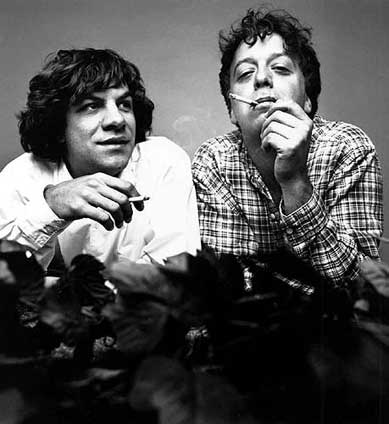
Dean (l) and Gene WeenHas Ween ever met a style it didn’t like? The ridiculously under-appreciated cult band has been cranking out albums for the past 18 years that free-range across the musical landscape -- prog rock, metal, boogie woogie, glam, reggae, alt-country, even a little mariachi – and do it with a sly combination of wit, sophistication and jaw-dropping crudity. They brought all that to DAR Constitution Hall on Wednesday, turning in a two and a half hour set that had the small but crazy-in-love audience on its feet the whole night, cheering on classics like “Spinal Meningitis (Got Me Down),” “Bananas and Blow” and the aggressive little love song, “Wavin’ My D*ck in the Wind.”
Ween, for the uninitiated, is Gene and Dean Ween – or, as their birth certificates would have it, Aaron Freeman and Mickey Melchiondo. World-class ironists who insist -- oh, the irony -- that they’re not being ironic at all, they shift from style to style with easy virtuosity, and from the sublime to the raunchy without taking either too seriously. That was clear in some of the best music of the night, which came from their latest disc, La Cucaracha -- including the angry blues-rock number “With My Own Bare Hands,” the faux-smarmy “Your Party” and an upbeat version of “Object.”
And despite a few weak moments – a lackluster “I Got to Put the Hammer Down” and a narcoticized version of “Zoloft” didn’t exactly make musical history – the rest of the evening was hard-driving goodness. Gene Ween’s a sharp, funny singer (and turned in some mean mandolin on “Ocean Man”), but it was really Dean’s guitar playing that drove the show. From the finger-melting delivery of “I’ll be Your Jonny on the Spot” to his channeling of Hendrix in the Afro-Caribbean boogie “Voodoo Lady,” he’s one of the more brain-bending guitarists around. Both got superb support from their backup trio, including the stick-twirling Claude Coleman Jr. on drums, Glenn McLelland on keyboards, and Dave Dreiwitz providing fine, funky bass work throughout.
Darkness and Light from the Left Bank Quartet
By Stephen Brookes • The Washington Post • January 15, 2008
_______________________________________________________________________________

Sally McLain, David Salness, Katherine Murdock, and Evelyn Elsing When the Left Bank Concert Society took the stage at the Terrace Theater on Sunday, the lights dipped for a moment into total blackness. The audience twittered -- some kind of technical error? But as the lights rose again and the quartet began to play, it turned out to be a fitting (if slightly theatrical) launch to a program titled "Darkness and Light."
Chiaroscuro is nothing new in music, of course -- the best is always complexly lit, nuanced with shadows and subtle, elusive colors. That was certainly true of György Kurtág's "Hommage a András Mihály," a set of 12 miniatures that opened the program. Rivaling Webern in concision and brevity, each was a perfect haiku of sound, evocative and utterly beguiling -- like luminous shells on the beach of a distant planet.

Gyorgy Kurtag But then came the dark side. Some people claim to love the music of Paul Hindemith; others find it needs way too much chewing before swallowing. Case in point: the heavy-treading song cycle "Des Todes Tod," whose titles -- "Vision of Death and Misery," "God's Death" and "Death's Death" -- give away the cheerful gist. The insightful mezzo Delores Ziegler exhumed considerable beauty from the low-voiced score, keeping it alive despite a pace so ponderous it threatened to expire on the spot.
Daylight returned again with more superb Kurtág ("Six Moments Musicaux," Op. 44) and the closing work, Brahms's radiant String Quartet in B-flat, Op. 67. It was the composer's favorite of his three quartets, perhaps because it's so relaxed and full of life; it's a work impossible not to fall for. The Left Bank players gave it an effusive, even rambunctious reading, and if they sacrificed delicacy for pure unbuttoned pleasure, so be it -- it's a trade-off worth making.
Dandelion
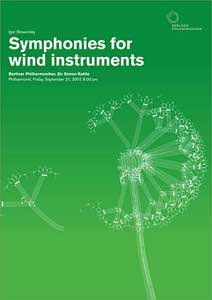 Just a wonderful graphic ... click here for large (from the Berlin Philhamonic).
Just a wonderful graphic ... click here for large (from the Berlin Philhamonic).
At the Portrait Gallery, a Spanish "Legacy"
By Stephen Brookes • The Washington Post • January 3, 2008
___________________________________________________________________________________
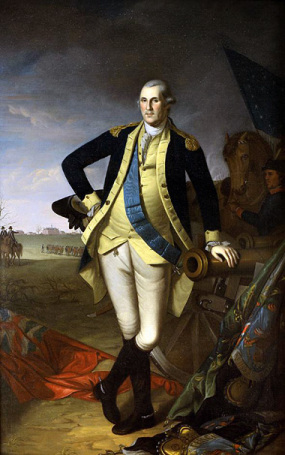
George Washington by Charles Willson Peale It's the celestial glow around George Washington that first grabs you; the sort of adoring, direct-from-heaven spotlight that painters reserve for Men of Destiny.
Leaning casually on a cannon, Washington looks supremely confident; storm clouds are giving way to blue skies overhead, and the flags of his enemies lie in the mud at his feet. Victory at the Battle of Princeton has brought the American struggle for independence to a turning point, and every inch of the canvas seems to radiate optimism. It's a portrayal, you can't help thinking, not just of Washington but of the new American republic.
And significantly, "George Washington at the Battle of Princeton" was originally sent to Spain, as a diplomatic gesture of thanks. It was painted by Charles Willson Peale in 1779, the year that the Spanish king, Carlos III, had joined France in declaring war on Britain -- a move of enormous help to the Americans. But the gift also reflected the far more extensive, and even crucial, role that Spain had been playing in the birth of the United States for years.
That little-known relationship is the subject of a thought-provoking exhibit at the National Portrait Gallery titled "Legacy: Spain and the United States in the Age of Independence, 1763-1848." Spanning a period from the Treaty of Paris to Mexico's ceding of California, it's a collection of some 70 portraits, maps and treaties that attempt to shed some light on this still-shadowy corner of history.
And, while it's not always an easy exhibit to decipher, it's worth the effort. France, of course, was America's key partner in the fight for independence from Britain. But the exhibit makes clear that, without the critical help of Spain in everything from financial aid to military action, the War of Independence might have taken a different course. And much of the credit goes to the remarkable Spanish personalities of the day, from the influential Count of Aranda (a tireless champion of the American cause) to Jorge Ferragut (who led campaigns against the British in North Carolina) and Bernardo de Galvez, who tied up the British navy at Pensacola in 1781, making it easier for Washington to seize victory at Yorktown.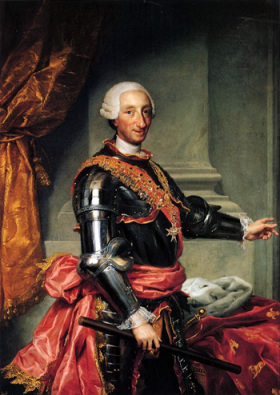
Carlos III, by Anton Raphael Mengs"The mission of the Portrait Gallery is not only to collect images of the people who made a difference in American history, but to tell aspects of that history," says Carolyn Kinder Carr, the deputy director of the National Portrait Gallery and co-curator of the exhibit. "We've laid out the show to have a dialogue between the people who interacted. The portraits, in some ways, are entry points into history."
The events that unfolded from 1763 onward involved a range of characters, from kings and diplomats to explorers, writers and religious and military leaders, and the exhibit includes telling portraits of many of them. At center stage for much of the period was King Carlos III, and it's his striking portrait (on loan from the Prado museum in Madrid) that opens the show. Painted in 1761 by Anton Raphael Mengs, it shows Carlos in full military regalia with all the trappings of power around him. But Carlos himself is smiling, and he seems anything but imperious; it's the portrait of a man open to ideas -- the embodiment of an era of reform and enlightenment.
On a purely artistic level, it's a hugely impressive collection as well, including five portraits by Francisco de Goya, four by Charles Willson Peale, six by Gilbert Stuart, and more by John Trumbull, Vicente Lopez, Thomas Sully and other more obscure artists. The Goyas alone, in fact, make the exhibit worthwhile.
Other standouts include the portrait of Benjamin Franklin (who, as Commissioner to Spain, persuaded Carlos III to send money, uniforms and equipment to the American cause) by Joseph Siffred Duplessis, and a fine 1834 painting of Davy Crockett (killed at the Alamo, in the fight for the independence of Texas) by Chester Harding.
Pulling all of these figures into a narrative spanning 85 years, two continents and the birth of a nation is an ambitious task by any standard, and the exhibit is often as frustrating as it is enlightening; casual visitors may find themselves quickly at sea. But the exhibit is still well worth viewing. Not only is the portraiture almost always superb, but the paintings also make up a vivid reminder of Spain's profound impact on American culture -- and even on the birth of the country itself.
Legacy: Spain and the United States in the Age of Independence, 1763-1848, continues through Feb. 10 at the National Portrait Gallery, Eighth and F streets NW.
Cambodian Modern: The Architectural Legacy of Vann Molyvann
By Stephen Brookes • Modernism Magazine • Winter 2007-08
____________________________________________________________________________________________________
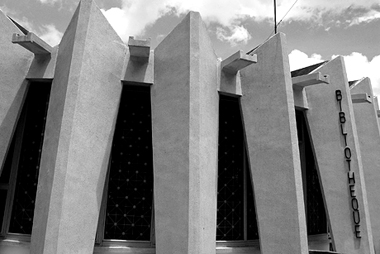
Institute for Foreign Languages, Phnom Penh Photos by Stephen Brookes It’s a still, clear morning in Phnom Penh, but storm clouds are gathering over one of the city’s most striking buildings. Empty and abandoned in an unkempt field, the light, sleek lines of the National Theater rise unexpectedly into the air, soaring over the bland office blocks and Buddhist temples nearby. With its sharp angles, walls of glass and playful interior spaces, it’s a tour de force of 1960’s modernism – utterly original, and as captivating as a mirage.
Designed in 1964 by the innovative Khmer architect Vann Molyvann, the theater is only one of dozens of important -- yet still little-known -- modernist buildings in Cambodia, all built during a spectacular architectural flowering between 1953 and 1970. Fusing European modernist ideas with Khmer vernacular architecture, Molyvann almost single-handedly changed the face of Phnom Penh, launching what’s come to be known as “New Khmer Architecture.” And while many of his masterpieces are under threat from new development, they still comprise one of the most intriguing collections of modernist architecture in Asia.
Known in the 1930’s as “the Pearl of the Orient,” Phnom Penh today is an open, low-slung city of broad avenues and tree-lined lanes, with an eclectic mix of pale yellow colonial villas, bland apartment blocks, elegant art deco buildings, graceful temples and tiny houses jammed up chockablock against each other.
And over the past decade, it’s been slowly coming to life. Cambodia spent most of the 20th Century enduring one nightmare after another – colonized by France, dragged into the Vietnam war, embroiled in civil strife, subjected to the horrors of the Khmer Rouge (when Phnom Penh was emptied) and invaded by the Vietnamese. And even now, though political stability seems to be restored, the country remains poor, corrupt and largely isolated.

Vann MolyvannBut there was one bright moment in the years right after the country’s 1953 independence from France. Determined to make the capital a symbol of Cambodia’s forward-looking, confident attitude, the ruling Prince Norodom Sihanouk commissioned more than 100 new buildings from a group of architects – led by the young Vann Molyvann, who had recently returned from studying with Le Corbusier at l’Ecole des Beaux-Arts in Paris.
Barely thirty, Molyvann was just four years younger than Sihanouk himself, and the two made a formidable team. There were already several modern architectural gems in the city, like the cruciform, deco-inspired Central Market from 1937 and the Phnom Penh Railway Station from 1932. But Molyvann had absorbed Le Corbusier’s ideas and wanted to infuse them with a distinctly Khmer sensibility, using elements from the ancient temples of Angkor and paying particular attention to the problems of flooding and extreme heat that Cambodia endures.
“We could not simply repeat things as they were done in Europe,” says Molyvann, who, at 81, still lives in the airy, light-filled house on Mao Tse Tung Boulevard he designed for himself in the late 1960’s. “We needed to think with new ideas, to build with a Cambodian approach.”

The National Sports Complex (1963-4)Many of those new ideas are embodied in what may be Molyvann’s most important work, the National Sports Complex. Built in 1963-64, it’s vast without being grandiose -- a 60,000-seat stadium, an 8,000 seat indoor sports hall, Olympic sized swimming pools and tennis courts, all seamlessly integrated in a 96-acre landscape of open courtyards and ornamental pools.
With its bold, muscular contours, the main sports hall makes an appropriately athletic statement. But inside, there’s a surprising openness to it; light and air filter in freely through the vented walls, and pools and streams run along the walkways, cooling the air and helping control the deluges of the monsoon.

Modernist "naga"And almost everywhere, there are references to the iconic temples of Angkor, which lie at the heart of Cambodia’s identity. The stadium’s pools echo the vast reservoirs -- known as “barays” -- which surround the temples to store water and contain flooding, while the elevated walkways reflect the massive one that leads into Angkor Wat. Even the louvered walls, which keep heat out but allow light in, reference the ancient temples.
That lively interplay between European modernism and Khmer vernacular architecture can be seen in virtually all of Molyvann’s buildings. The Independence Monument (1960), with its distinctive lotus-bud shape, emulates the Arc de Triomph yet is modeled on the central tower of Angkor Wat. The National Theater integrates the traditional “barays” with modern suspended staircases and cantilevered triangular roofs. And the Chaktomuk Conference Hall, though thoroughly contemporary, was modeled on the shape of the fan palm – a plant virtually emblematic of Cambodia’s rural villages.
Some of the most overt references to Angkor can be found at the Institute for Foreign Languages, next to the Royal University of Phnom Penh on Pochentong Boulevard. In homage to the kilometer-long entry passage at Angkor, it’s reached via a long elevated concrete walkway that leads to the main building. The walkway even includes modernist versions of “nagas” – the stone serpents that guard the Angkor temples.

Institute for Foreign LanguagesAnd here, too, modern materials have been adapted to traditional uses. While the buildings are largely brick and concrete, they are designed to minimize direct sunlight, maximize airflow and control the risk of flooding. But there’s a whimsical quality about them, as well; the Institute’s library is modeled after traditional woven palm-leaf hats (and is set in its own small, circular moat), and the lecture halls are cantilevered imaginatively out over angled “legs” that give them a coiled, animal-like energy.
The Institute for Foreign Languages is still in active use, as are many of Molyvann’s other enduring designs, including the Ministry of Finance, the Council of Ministers, and the “100 Houses” residential housing project. But others are decaying, and many are threatened by the helter-skelter development now underway almost everywhere in the city. Real estate speculation and a lack of oversight, says Molyvann, have resulted in reckless building – with little respect for the environment or Cambodia’s architectural heritage.

The National TheaterA planned renovation of the National Sports Complex, for example, has turned into a disaster. A Taiwanese company was given the contract to restore the main buildings in 2000, in exchange for the right to build on some of the surrounding grounds. But the developers filled in Molyvann’s carefully planned ponds (leading to flooding in the area), threw up a cheap, ugly retail building next to the stadium, and haven’t even begun the renovation.
The National Theater (also known as the Tonle Bassac Theater) faces an even more urgent threat. It’s been steadily deteriorating since a fire gutted much of it in 1994, destroying the distinctive glass pyramid at its top. Cambodia’s current King, Norodom Sihamoni, has said that he wants to see it rebuilt, but no funding has been provided, and the Theater is largely boarded up. A local telecommunications company, meanwhile, is reported to want the site for other uses.
“The land there is too valuable now,” says Molyvann, sitting at a book-filled desk in his home in Phnom Penh, “and it’s expensive to renovate. The Bassac Theater will be destroyed. They want to put in a department store.”

Interior, National TheaterFor other buildings, it may already be too late. Molyvann introduced apartment blocks to Cambodia with his two Front du Bassac buildings from the mid-1960’s, designed along Le Corbusier’s idea of the “modular.” Once landmarks, their striking design has largely been obliterated. One was renovated beyond all recognition, turned into a faceless box and renamed, ironically, the “Build Bright University.” The other is in terrible condition and is likely to be torn down, says one architect in Phnom Penh, to make room for a 46-story development.
“We’re starting to introduce property rights, respect for law and so on,” says Molyvann, as the sound of construction drifts up from the busy street below. “But I’m concerned about the future. In ten years, I don’t know what will be left.”
••••••••
Touring Phnom Penh's Architecture: A Quick Guide
Phnom Penh is a manageably sized city, and most of the important modernist structures can be absorbed in a day. The best way to see them is in an open-air tuk-tuk with an architect as your guide, which a non-profit group called Khmer Architecture Tours can arrange for well under $100 for a full day. Before you go, get the essential “Building Cambodia: New Khmer Architecture 1953-1970” by Darryl Collins and Helen Grant Ross.

The Hotel Le Royal, Phnom PenhWhile there are plenty of hotels in Phnom Penh, few hold much architectural interest. One notable exception is the historic Hotel Le Royal, built in 1929. A luxurious oasis from Phnom Penh’s gritty streets, it was carefully restored by Raffles in 1997 with a blend of colonial and art deco styles and, at about $130 a night, is a bargain. It’s worth a tour on its own, as is the nearby National Library (or Bibliotheque) from 1922, a stylish and well-preserved example of French neo-classical architecture.
Other interesting hotels include Le Pavillon, a lovingly rebuilt French colonial villa (about $50 a night) and the popular Foreign Correspondents Club, in a fine colonial-era building along the river. Its stylish (but rather noisy) rooms run about $60 a night, and the open-air restaurant on the top floor is the best place in the city for mid-century surroundings and great views of the waterfront.

The Foreign Correspondents Club, Phom PenhShopping for vintage artifacts is a challenge in Cambodia -- during their 1975-1979 rule, the Khmer Rouge tried to wipe out all evidence of the country's culture, and few items from the colonial era survived. As always in Asia, the best way to find unusual pieces is to locate a resourceful dealer, tell him what you want, then just wait a few days; the results can be remarkable.
But there are a few shops in Phnom Penh where interesting things surface from time to time: Bazar, art de vivre (28 Sihanouk Boulevard) has a worthwhile collection of mostly-Asian furniture and antiques, and there are several dusty little antique shops along Street 240 with a constantly-changing selection of curiosities. Our favorite was the chic, eclectic Le Lezard Bleu (61 Street 240), which had a fine selection of 20th-century paintings ($20 to $1,500), as well as reproductions of art deco furniture (nicely designed, but a bit rough around the edges) starting at $200.
Elsewhere in Cambodia:
There are modernist gems outside of Phnom Penh, too, including a deco-filled 1930 house in Battambang called La Villa that recently opened as a six-room hotel, and the Molyvann-designed SKD Brewery and the National Bank of Cambodia in the southern coastal town of Sihanoukville.
Also on the coast is the town of Kep, which flourished as a seaside resort during the 1960s. Amid the palm trees are some intriguing modernist villas (Sihanouk had one built here), and three of the finest have been restored and turned into the elegant 11-room Knai Bang Chatt resort. Its main building, the multi-terraced Blue Villa from 1962, is a lively three-story house with balconies looking out over the sea.

The Amansara resort in Siem ReapTo get to the heart of Khmer architecture, though, it’s necessary to head north to the temples of Angkor. And as it happens, one of the country’s finest examples of mid-century residential architecture is in the neighboring town of Siem Reap. Designed by the French architect Laurent Mondet, the sleek, elegant Villa Princiere was built in 1962 by Prince Sihanouk as a guesthouse for visiting dignitaries. In its heyday, luminaries including Leonid Brezhnev, Peter O’Toole and Jackie Onassis all basked by its whimsical zigzag pool and dined in the circular dining room, where the Prince screened his latest films.
Though it fell into near-ruin during the Khmer Rouge era, Amanresorts bought the property and thoroughly renovated it in 2002, under the direction of Kerry Hill Architects in Australia. Enlarging and modernizing the rooms, they used a minimalist color scheme of whites and grays to emphasize the clean, austere lines of the buildings. Rather than trying to incorporate traditional Khmer references, they stayed true to the original 60’s style, with superb results; the Prince’s villa, now known as the Amansara, is a must-see on any architectural tour of Asia.
The recent development of Siem Reap has had other benefits; a number of colonial buildings in the old French Quarter have been renovated and turned into restaurants, art galleries and guest houses, and there are now over 100 hotels in the town. The most architecturally entertaining is the high-end Hotel de la Paix (designed by Bill Bensley), which mixes art deco, Angkor references and international chic with cheerful abandon. With gas-fired sconces over its entrance and hanging beds in the courtyard, it may be over the top for some tastes, but its architectural playfulness is guaranteed to keep you smiling – and its restaurant, Meric, may be the best in the entire country.
Feet Accompli in St. Michaels
By Stephen Brookes • The Washington Post • December 23, 2007
____________________________________________________________________________________________________
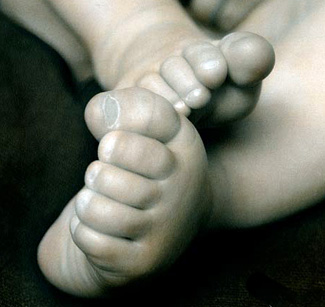
Saelon Renkes It was cold, and storm clouds were gathering over our house. Just back from three weeks in Kabul, my wife was jet-lagged and exhausted, and I was snowed under with deadlines. We'd missed an anniversary, the roof had sprung a leak, a significant-decade birthday was imminent and the nightmare of Christmas -- with its annual plea for a pony -- was closing in fast.
And then there was the issue of my feet.
"Look at those things," she muttered one night, as I read barefoot on the couch. "They're a disgrace."
I looked down: Thick calluses, ripsaw nails, skin that only an iguana could love. I'd always thought my feet were honest, workmanlike things, good for getting from one place to another. But now they'd been revealed for what they really were: damnable objects of shame.
"You need -- repeat, need -- a pedicure," she said. "Let's go to a spa. You'll like it. You'll have baby feet. Giant baby feet!"
Now, like many men, I'm instinctively spa-averse. Spas aren't our turf, and we know it. Most of us would no more wander into one than try on lipstick at Nordstrom's.
But according to the International Spa Association, there are more than 14,000 spas across the country, and they're becoming an inescapable part of modern life. And I had to admit, I was curious. Clearly we both needed a break. Why not get out of town, treat ourselves to some pampering and come home ready to rock the holidays?
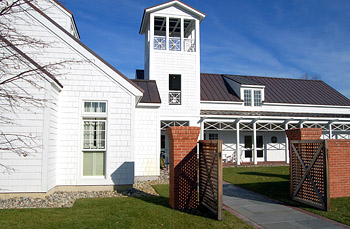
The Linden Spa, St Michaels Stephen BrookesSo a few days later, we found ourselves on Maryland's Eastern Shore, heading into the quaint resort town of St. Michaels. In summer, it's the go-to place for sailing, fishing and other outdoor fun. But the town has been reinventing itself as a winter destination, too, and not just for people who like dredging for oysters in the snow. With the summer tourists gone, life slows to a relaxing pace, and you can absorb the town's Victorian charms in peace. Or, if you prefer, just get massaged into a coma.
St. Michaels has long had two fine, fully equipped spas, one at the Harbour Inn and the other at the Five Gables Inn. We'd heard, though, about a spectacular newcomer: a state-of-the-art, 6,000-square-foot palace called the Linden Spa, which opened this summer. Not only did it have everything we could possibly need -- yoga classes, a gym, a steam room and a small army of masseurs and masseuses -- it was also attached to the ultra-luxurious Inn at Perry Cabin. If the spa didn't completely relax us, we figured we'd just let the inn itself finish the job.
So within a half-hour of arriving, we found ourselves walking through the Linden Spa and chatting with its sprightly young director, Jenny Farrand. Hotel spas tend to be dim, cavelike places, often tucked into an unused corner of the basement. But the Linden Spa was a light-filled building set apart from the inn, with the clean, open lines of an art museum. Elegantly pressed and framed flowers lined the walls of the "relaxation room," which looked out into a charming brick-walled garden, and everything about the spa seemed designed to soothe, from the color scheme (white and natural wood) to the furniture (wicker and cork) to the bathrobes (organic cotton, of course) that hung in the changing rooms.
"We've come to be rejuvenated," I told Farrand. She confirmed we'd come to the right place.
"But here's the problem," I said, looking around at the bottles of face lotion, the pastel yoga mats, the little soaps made of rare flowers. "I'm not a woman."
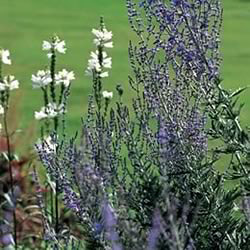
Linden Spa"Oh, that's all right -- you're not alone," she assured me. Forty percent of her clients were male, she said, and anyway, spas aren't about feminine pampering anymore: They're about health. Most of her male clients just go for massages, she said, but the bolder, more adventurous ones -- the real men -- were venturing into previously forbidden realms.
She opened the spa's catalogue to show me. There were seven kinds of facials and a vast array of massages, from "deep tissue" and "hot stone" to something called "moon and tide." There were pedicures and manicures and body-firming masks by the score, all topped off with a bewildering assortment of "finishing touches." And nearly all, she assured me, were appropriate for men.
My wife looked like she'd just been teleported to nirvana. But I was way, way out of my depth.
"What about the Linden Ritual?" I asked. It was the spa's signature treatment, where they smear you with sage, rosemary and other spices, wrap you in hot towels to bake, and then scrub you down with salt before tenderizing you on the massage table. It sounded delicious, in a vaguely cannibalistic way.
"Sure!" said Farrand, who swore that being wrapped in herbs would make us healthier. "The molecules actually enter your skin," she said, "and draw toxins out of your body."
I'd heard about these treatments; apparently it is becoming increasingly common for spas to baste their clients in the local cuisine. At one spa in Arizona they wrap you up in cactus flowers. In Hershey, Pa., they smear you with chocolate. And in Texas, they use barbecue sauce. Naturally.
Do any of these things have any actual health benefit? Who knows? But the Linden Spa's mantra is "the botanical art of wellness," and it takes its mission seriously. The spa is named after the native linden trees on the property (it uses the leaves to make tea), and it grows most of the other herbs in a greenhouse behind the spa, mixing up the potions in its own apothecary.
It was clear that at least one of us would have to be wrapped in spices, so I volunteered my wife. She quickly settled on the Five Flowers Solace (80 minutes, $165), where you're coated in hot, flower-infused clay; it's cooled to a crust and then the whole mess is scrubbed off. It sounded like a cruel joke, but I kept my mouth shut; better her than me. And I turned to Farrand for one last piece of advice.
"So, what do Cheney and Rumsfeld get when they come here?" I asked.
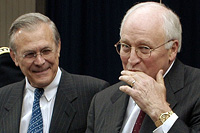
National spa secrets: safe with usThe veep and the former defense secretary are St. Michaels's two most famous homeowners, and I figured that if they actually did sneak in once in a while to be lathered in organic buttermilk, it would be okay if I did, too. But Farrand just smiled discreetly; if she knows our national primping secrets, she's not telling.
Instead, she suggested the Classic Pedicure ($49) and something called the Herbal Remedy Massage ($185), a treatment involving ginger and lemon grass that ancient Thai warriors supposedly used to recover from battle. Confident that Rummy would approve, I agreed.
So the next morning, swaddled in a fluffy white robe and holding a cup of linden tea in one hand, I met my pedicurist -- sorry, my nail technician -- a charming young woman named Samantha. She guided me up some steps to a white pleather throne with a little whirlpool bath at its base.
"Is this your first time?" she asked. She was speaking in a low, soothing "spa" voice, as if I'd just had a serious brain injury, and I suddenly realized that the spa experience wasn't really feminizing -- it was infantilizing. That's when I began to babble.
"My wife wants me to have baby feet!" I told her.
"That's right," she said, in her calming, don't-panic voice. "You'll have baby feet. Now just put them in the tub for me."
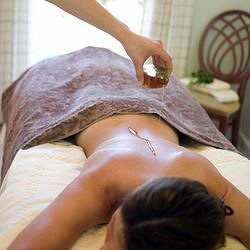
Linden Spa
And that's when I began to really understand what spas were all about. For the next 45 minutes, my battered feet were massaged, buffed, oiled and groomed to perfection -- transformed from oafish lumps into objects of innocence and grace. For the first time in their lives, they were, dare I say it, beautiful. Using them for walking seemed an indignity. I wanted to have them bronzed.
But my rejuvenation was just beginning. Samantha passed me to a masseuse named Lakia, who stretched me out on a warm massage bed and, for the next 80 minutes, expertly soothed every shred of tension from my body. Rubbing me with aromatic oils and pressing deep into my muscles with a warm poultice of Thai herbs, she gave me a sort of acupressure massage unlike anything I'd ever experienced. The scent of the herbs was almost intoxicating, and as the tensions dissolved, I drifted into a blissful, oceanic state of peace -- or, as spa people call it, "the drool zone."
"How was it?" Farrand asked us later, after we'd met up in the relaxation room and were floating to the door to check out. I looked at my wife, who was in some peaceful land beyond human speech. The hot clay had clearly done its work.
"Fantastic," I admitted. "But I feel like I should go do something manly now."
"Just relax," she said, with a knowing smile. "You'll be fine."
••••••
St. Michaels: It's Not Just For Summer Anymore
It may be most famous as a summer destination, but St. Michaels is perfect for a quick winter getaway, too. Here are some ways to spend a weekend on the Chesapeake.
GETTING THERE: St. Michaels is less than a two-hour drive from Washington. Take Route 50 east across the Chesapeake Bay Bridge, stay on 50 when it splits with Route 301 and follow it 30 more miles to Easton. About a half-mile past Easton Airport, bear right onto Route 322. Go two miles, and at the traffic light, turn right onto Route 33; you'll glide right into St. Michaels.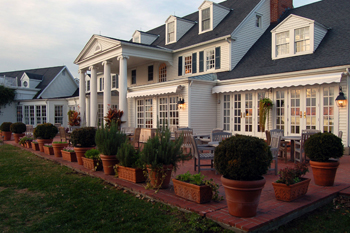
The Inn at Perry Cabin Stephen BrookesWHERE TO STAY: There are any number of comfortable, impossibly charming 19th-century inns in and around St. Michaels, though some -- like the wonderful Wades Point Inn -- close in the winter. At the upper end is the Inn at Perry Cabin (308 Watkins Lane, 410-745-2200) on the banks of the Miles River. Built in 1816, the inn was recently updated by Orient-Express and reeks of elegance and old money; you can even park your 130-foot yacht there. Its 81 quiet, antique-filled rooms and suites run from $330 to $770 per night double, with special packages available.
A more casual alternative is the Five Gables Inn and Spa (209 N. Talbot St., 410-745-0100) -- actually three Victorian houses near the heart of town, with an Aveda spa, an indoor pool and rooms painted in lively Caribbean colors. Its 20 rooms start at $150 a night, and its Pity the Procrastinator special rewards early bookers with a $50 credit toward dining in St. Michaels.
Other choices include Aida's Victoriana Inn (205 Cherry St., 410-745-3368; from $135), the Dr. Dodson House (200 Cherry St., 410-745-3691; from $165) and the Black Walnut Point Inn on Tilghman Island (410-886-2452; from $120). For more modern accommodations, try the St. Michaels Harbour Inn (101 N. Harbor Rd., 410-745-9001; from $180).
WHERE TO EAT: Grab a cappuccino at St. Michaels Perk Coffeehouse (402 S. Talbot St.) or a sandwich at the Carpenter Street Saloon (113 S. Talbot St.), where you can also display your karaoke skills on Tuesday nights. For a lively bar scene in the evening, check out the Characters Cafe across the street.
But don't leave St. Michaels without trying at least a few of its better restaurants -- particularly Bistro St. Michaels (403 S. Talbot St.), whose range of inventive, subtly flavored dishes never fails to delight; I recommend the scallops with coconut curry green beans ($27). The Bistro is always busy, so call 410-745-9111 well ahead for reservations. Also a good bet is 208 Talbot, where I tried the $55 prix- fixe menu offered on Saturday night. The food wasn't quite as memorable, but it's worth sampling the Southern-inflected inventions of chef Brendan Keegan.
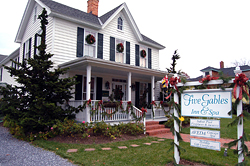
Five Gables Inn, St MichaelsAnd it's practically illegal to visit St. Michaels without at least one meal at Sherwood's Landing, the nautical-theme restaurant at the Inn at Perry Cabin. Aside from the superb Continental cuisine (and 10,000-bottle wine cellar), part of the fun is the spectacular view of the Miles River during the day and the roaring fireplace in the evening. The chef's honey-and-tarragon-glazed shank of lamb will warm you up on a winter's night, and the seared jumbo scallops were superb. Dinner entrees run $30 to $39. Call 410-745-2200 for reservations.
PAMPER YOURSELF: There are three pleasant, well-equipped spas in St. Michaels, each offering a wide range of services with their own distinctive character. The newest (and most luxurious) is the Linden Spa at the Inn at Perry Cabin (308 Watkins Lane, 410-745-2200). Signature treatments such as the Linden Ritual (110 minutes, $420) and the Five Flower Solace (80 minutes, $165) use local medicinal plants. The two-story, 6,000-square-foot facility also has a gym, yoga classes, indoor and outdoor relaxation rooms and an infinity pool.
You'll find facial treatments ($95 to $135), massages ($110 to $185) and other treatments at the Spa at Harbour Inn (101 N. Harbor Rd., 410-745-0646). Those in need of more serious pampering may want to try the Winter Detox (herbal wrap, hot stone therapy, reflexology) for $325.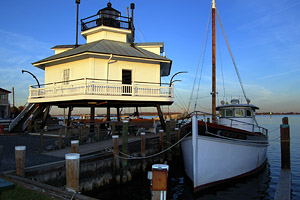
Chesapeake Bay Maritime Museum Stephen BrookesThe Five Gables Inn (209 N. Talbot St., 410-745-0100) has an indoor swimming pool and a steam room complementing its Aveda spa. A basic one-hour massage runs $100; for $175 you can have a 90-minute hot stone massage. Other treatments include facials ($110) and a sea-salt body polish (90 minutes, $150). New on the menu is the 90-minute Caribbean Therapy Body Treatment ($165), which includes a seaweed masque, body wrap, face massage and restorative body massage.
DON'T JUST SIT THERE: There's nothing like being rubbed down with warm, aromatic oils when it's freezing outside. But if you feel the urge to actually move around the town, consider visiting the Chesapeake Bay Maritime Museum (213 N. Talbot St., 410-745-2916; $13). It's open all year, and you can spend a fascinating day working with skilled craftsmen as they build wooden boats ($25 fee). There are also kids' programs on Jan. 5 and 19; call for details.
For a more dramatic -- if colder -- maritime experience, try winter dredging for oysters on a traditional skipjack with Captain Wade H. Murphy Jr; call him at 410-829-3976 to arrange a trip. Landlubbers may prefer to visit the Pickering Creek Audubon Center, a few miles north of nearby Easton, for its free Invasives Eradication Workdays held Jan. 26, Feb. 23 and March 22. You'll be put to work yanking up English ivy from the waterfront; you'll feel better, and the bay will thank you. Info: 410-822-4903.
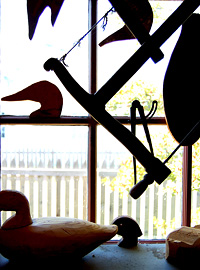 Clay shooting, as well as goose and duck hunting, are other fresh-air options. Duck season runs through Jan. 26, and companies such as Professional Guide Service (410-745-2433) will arrange hunts on private farms.
Clay shooting, as well as goose and duck hunting, are other fresh-air options. Duck season runs through Jan. 26, and companies such as Professional Guide Service (410-745-2433) will arrange hunts on private farms.
There's plenty to do indoors as well. The Inn at Perry Cabin (410-745-2200) is holding cooking demonstrations with chef Mark Salter in February and March ($75 per person, including dinner); get him to show you how to make his Grand Marnier Souffle, and you'll never lack for friends. The inn also offers jazz nights (select Saturday nights January through March; packages, including tickets, lodging and dinner for two, start at $525). For more culture, head to nearby Easton, where the Avalon Theatre (410-822-7299) presents performances all winter, including the Temptations (Jan. 31), the legendary Taj Mahal (Feb. 17) and the music of Puccini, Beethoven and Brahms. Tickets $10 to $60.
EXERCISE THE CHARGE CARD: The chief entertainment in St. Michaels may be shopping, and the main drag of Talbot Street boasts gift shops selling a near-endless supply of Chesapeake-theme knickknacks; if you've been looking for a coffee mug that says, "I'm Feeling Crabby," you've come to the right place. Try A Wish Called Wanda and 3 Krazy Ladies for some of the more entertaining stuff, or pick up expensive froufrou for your loved one at Flying Fred's pet boutique. A little more upscale is Artiste Locale & Frivolous Fibers, where you can acquire a meticulously handcrafted thumb piano (as, um, played by the indigenous watermen?) and other intriguing, if occasionally baffling, objets d'art. If you're out to spend grown-up money, head down Route 33 toward Tilghman Island and take the turnoff toward Sherwood. Immediately on your left will be Sherwood Antiques (410-886-2562). It may not look like much from the outside, but there's a superb collection of carpets, hand-cut crystal and 18th-century furniture inside, and owner Charlie Freeman will happily show you around. (If you're looking for a Christmas present for me, the 1920 model of the clipper ship Mary Knowles -- a paltry $1,250 -- would be perfect.)
If you're out to spend grown-up money, head down Route 33 toward Tilghman Island and take the turnoff toward Sherwood. Immediately on your left will be Sherwood Antiques (410-886-2562). It may not look like much from the outside, but there's a superb collection of carpets, hand-cut crystal and 18th-century furniture inside, and owner Charlie Freeman will happily show you around. (If you're looking for a Christmas present for me, the 1920 model of the clipper ship Mary Knowles -- a paltry $1,250 -- would be perfect.)
Haskell Small Plays Mompou
By Stephen Brookes • The Washington Post • December 18, 2007 _______________________________________________________________
It takes courage for a pianist to program a concert of works by a single composer. Double -- maybe triple -- that courage when the composer is Federico Mompou, a fascinating if obscure Spaniard whose austere, inward-looking works offer little in the way of crowd-pleasing virtuosity.
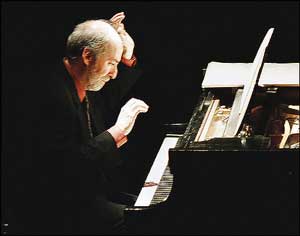 But, as pianist Haskell Small showed in an unusual recital Sunday at the Phillips Collection, Mompou's music is worth attention. Small devoted the afternoon to what may be the composer's masterpiece, a 28-part work from the 1960s called "Musica Callada" (roughly translated "Music of Silence") that lasts a little more than an hour. It's not music for the casual listener; there's little drama or much sense of forward motion, and the pieces rarely move beyond a moderate tempo. But what extraordinary music this was: Spare, meditative, even mystical, it used a minimal vocabulary to achieve a vast sense of scale. And each movement felt almost shockingly authentic, as if Mompou had stripped away everything superfluous in himself and was writing directly from the core.
But, as pianist Haskell Small showed in an unusual recital Sunday at the Phillips Collection, Mompou's music is worth attention. Small devoted the afternoon to what may be the composer's masterpiece, a 28-part work from the 1960s called "Musica Callada" (roughly translated "Music of Silence") that lasts a little more than an hour. It's not music for the casual listener; there's little drama or much sense of forward motion, and the pieces rarely move beyond a moderate tempo. But what extraordinary music this was: Spare, meditative, even mystical, it used a minimal vocabulary to achieve a vast sense of scale. And each movement felt almost shockingly authentic, as if Mompou had stripped away everything superfluous in himself and was writing directly from the core.
Much of the credit goes to Small, who may be better known to Phillips audiences for fine performances of his own works. Not every pianist has the temperament or the insight to play Mompou well, but Small had clearly internalized the work and brought it off with exceptional gravity and focus. Each movement had a life and character of its own -- from Satie-like translucence to almost frightening desolation -- while connecting to the others with natural grace. High marks to Small on courage alone; even higher for a riveting performance.

